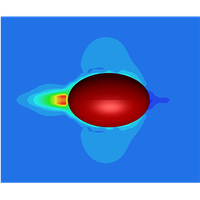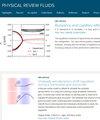复杂流体中的球形唧筒建模
IF 2.5
3区 物理与天体物理
Q2 PHYSICS, FLUIDS & PLASMAS
引用次数: 0
摘要
我们用包含流体惯性的 Giesekus 构成方程模拟了球形游泳者在复杂流体中的运动。我们建立了一个球形游泳者模型,并在直接强迫虚构域法框架中对其进行了应用。该模型扩展了传统的球形 "squirmer",代表了通过边界切向表面波产生自推进力的微型游泳者。我们分别在 1.5≤AR≤8 和 0.5≤Wi≤10 的范围内改变游泳者的长宽比(AR)和魏森伯格数(Wi;流体弹性力与粘性力之比)。我们的研究结果表明,具有较小 |β|(游泳强度参数)的惯性球形拉力器的游泳速度快于受斯托克斯流机制影响的球形拉力器,这与在球形拉力器中观察到的模式不同。在 Giesekus 流体介质中,增大的流动因子 α 与松鼠速度的增加相关,而在存在流体惯性的情况下,较大的 AR 会显著提高中性松鼠的速度。同时,我们还探讨了松鼠的能量消耗和流体动力学效率,发现在游泳强度较大的情况下,纤细的惯性松鼠会消耗更多的能量,而在游泳强度较小的情况下,能量消耗则会减少。值得注意的是,较大的AR与松鼠的效率呈正相关,与游泳速度呈优势关系。本文章由计算机程序翻译,如有差异,请以英文原文为准。

Modeling a spheroidal squirmer through a complex fluid
We simulate a spheroidal swimmer through a complex fluid, modeled by the Giesekus constitutive equation incorporating fluid inertia. We develop a spheroidal swimmer model and exert it in a direct-forcing fictitious domain method framework. This model extends the conventional spherical “squirmer,” representing a microswimmer generating self-propulsion through tangential surface waves at its boundaries. We vary the swimmer's aspect ratio (AR) and Weissenberg number (Wi; the ratio of fluid elastic force to viscous force), respectively, in the range of and . Our results show that, an inertial spheroidal puller with a small (a swimming intensity parameter) swims faster than the counterpart subjected to the Stokes flow regime—a departure from the observed pattern in spherical pullers. Within the Giesekus fluid medium, an augmented mobility factor α correlates with an increased squirmer velocity, while a larger AR contributes significantly to the speed enhancement of a neutral squirmer in the presence of fluid inertia. Meanwhile, we explore the squirmer's energy expenditure and hydrodynamic efficiency, finding that a slenderer, inertial squirmer with a vigorous swimming intensity expends more energy, contrasting with the reduced energy expenditure associated with a smaller intensity. Notably, a larger AR positively correlates with squirmer efficiency, displaying an advantageous relationship with swimming speed.
求助全文
通过发布文献求助,成功后即可免费获取论文全文。
去求助
来源期刊

Physical Review Fluids
Chemical Engineering-Fluid Flow and Transfer Processes
CiteScore
5.10
自引率
11.10%
发文量
488
期刊介绍:
Physical Review Fluids is APS’s newest online-only journal dedicated to publishing innovative research that will significantly advance the fundamental understanding of fluid dynamics. Physical Review Fluids expands the scope of the APS journals to include additional areas of fluid dynamics research, complements the existing Physical Review collection, and maintains the same quality and reputation that authors and subscribers expect from APS. The journal is published with the endorsement of the APS Division of Fluid Dynamics.
 求助内容:
求助内容: 应助结果提醒方式:
应助结果提醒方式:


